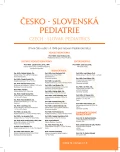The effect of adenoids and endoscopic adenoidectomy on nasal patency in children
Authors:
J. Sojak 1,3; P. Ďurdík 2; R. Péčová 3,4
Authors‘ workplace:
Slovenská zdravotnícka univerzita v Bratislave, Lekárska fakulta Slovenskej zdravotníckej univerzity
Klinika otorinolaryngológie a chirurgie hlavy a krku, Ústredná vojenská nemocnica SNP –
Fakultná nemocnica, Ružomberok
1; Univerzita Komenského v Bratislave, Jesseniova lekárska fakulta v Martine (JLF UK), Klinika detí
a dorastu, Univerzitná nemocnica, Martin
2; Ústav patologickej fyziológie JLF UK, Martin
3; Martinské centrum pre biomedicínu JLF UK, Martin
4
Published in:
Čes-slov Pediat 2017; 72 (3): 170-175.
Category:
Original Papers
Overview
Background:
The aim of this study was to clarify changes of nasal obstruction, transnasal airflow and resistance resulting from adenoid hypertrophy and to assess the effect of endoscopic adenoidectomy.
Methods:
Altogether 156 children (average age of 6.7 years, with average high of 123 cm) were submitted to a nasal fiberoptic endoscopy, condition of nasopharynx and the grade of eventual adenoid hypertrophy was determined, according to which the children were divided into groups. We also conducted active anterior rhinomanometry (transnasal pressure 150 Pa) and assessed values of total transnasal inspiratory airflow (Fl.L+R) and total nasal resistance (ResL+R). We compared this values with reference parameters and assessed grade of nasal obstruction for all groups. In group of 50 children we conducted these measurements also after adenoidectomy and assessed the change of nasal patency due to adenoidectomy.
Results:
In a group of 151 children with verified adenoid hypertrophy we measured value of Fl.L+R corresponding to 60% and value of ResL+R corresponding to 233% of reference parameters what correlate with 2nd grade of nasal obstruction. We have noticed statistically significant decrease of Fl.L+R (p=0.01) and increase of ResL+R (p=0.012) due to adenoid hypertrophy. Also we have noticed relationship between increase of adenoid hypertrophy grade and grade of nasal obstruction. The grade of nasal obstruction due to AT statistically changed (p=0.028) and we recorded improvement of 0.58 grade. Value of Fl.L+R after adenoidectomy correlated with 2nd grade of nasal obstruction. We have not observed relevant changes in nasal obstruction after adenoidectomy in children with 2nd grade of adenoid hypertrophy; in children with 3rd grade of adenoid hypertrophy we have observed improvement of 1.11 nasal obstruction grade.
Conclusions:
In our study we have confirmed negative influence of adenoid hypertrophy on nasal obstruction and patency. Higher grade of adenoid hypertrophy relate with higher grade of nasal obstruction. The significant reduction of nasal obstruction symptoms after adenoidectomy might be expected only in group of patients with the 3rd and 4th grade of adenoid hypertrophy respectively 3rd and 4th grade of nasal obstruction.
Key words:
adenoids, adenoidectomy, nasal obstruction, nasal patency, rhinoendoscopy, rhinomanometry
Sources
1. Papaioannou G, Kambas I, Tsaoussoglou M, et al. Age-dependent changes in the size of adenotonsillar tissue in childhood: implications for sleep-disordered breathing. J Pediatr 2013; 162 (2): 269–274.
2. Rajeshwary A, Rai S, Somayaji G, et al. Bacteriology of symptomatic adenoids in children. N Am J Med Sci 2013; 5 (2): 113–118.
3. Zicari AM, Rugiano A, Ragusa G, et al. The evaluation of adenoid hypertrophy and obstruction grading based on rhinomanometry after nasal decongestant test in children. Eur Rev Med Pharmacol Sci 2013; 17 (21): 2962–2967.
4. Lertsburapa K, Schroeder JW Jr, Sullivan C. Assassment od adenoidal size: a comparison of lateral radiographic measurements, radiologist assessment, and nasal endoscopy. Int J Pediatr Otorhinolaryngol 2010; 74 (11): 1281–1285.
5. Kindermann CA, Roithmann R, Lubianca Neto JF. Sensitivity and specificity of nasal flexible fiberoptic endoscopy in the diagnosis of adenoid hypertrophy in children. Int J Pediatr Otorhinolaryngol 2008; 72 (1): 63–67.
6. McClay JE, Meyers AD. Adenoidectomy [online], 2013. Dostupný z www: http://emedicine.medscape.com/article/872216-overview.
7. Cassano P, Gelardi M, Cassano M, et al. Adenoid tissue rhinopharyngeal obstruction grading based on fiberendoscopic findings: a novel approach to therapeutic management. Int J Pediatr Otorhinolaryngol 2003; 67 (12): 1303–1309.
8. Příhodová I. Obstrukční spánková apnoe dětského věku. Čes-slov Pediat 2007; 62 (11): 631–663.
9. Dinis PB, Haider H, Gomes A. The effects of adenoid hypertrophy and subsequent adenoidectomy on pediatric nasal airway resistance. Am J Rhinol 1999; 13 (5): 363–369.
10. Chládková J. Chronic cough in children. Pediatr praxi 2014; 15 (1): 13–15.
11. Zapletal A, Chalupová J. Nasal airflow and resistance measured by active anterior rhinomanometry in healthy children and adolescents. Pediatr Pulmonol 2002; 33 (3): 174–180.
12. Ko JH, Kuo TB, Lee GS. Effect of postural change on nasal airway and autonomic nervous system established by rhinomanometry and heart rate variability analysis. Am J Rhinol 2008; 22 (2): 59–65.
13. Momiyama Y. Nasal resistance in school children and students. Nihon Jibiinkoka Gakkai Kaiho 1989; 92 (2): 194–206.
14. Andreassen ML, Leeper HA, MacRae DL, et al. Aerodynamic, acoustic, and perceptual changes following adenoidectomy. Cleft Palate Craniofac J 1994; 31 (4): 263–270.
15. Cullen KA, Hall MJ, Golosinskiy A. Ambulatory surgery in the United States, 2006. Natl Health Stat Report 2009; 28 (11): 1–25.
16. Duval M, Chung JC, Vaccani JP. A case-control study of repeated adenoidectomy in children. JAMA Otolaryngol Head Neck Surg 2013; 139 (1): 32–36.
17. Crysdale WS, Cole P, Emery P. Cephalometric radiographs, nasal airway resistance, and the effect of adenoidectomy. J Otolaryngol 1985; 14 (2): 92–94.
18. Maurizi M, Paludetti G, Ottaviani F, et al. Mucociliary function and nasal resistance evaluation before and after adenoidectomy. Int J Pediatr Otorhinolaryngol 1986; 11 (3): 295–300.
19. Fielder CP. The effect of adenoidectomy on nasal resistance to airflow. Acta Otolaryngol 1985; 100 (5–6): 444–449.
Labels
Neonatology Paediatrics General practitioner for children and adolescentsArticle was published in
Czech-Slovak Pediatrics

2017 Issue 3
- What Effect Can Be Expected from Limosilactobacillus reuteri in Mucositis and Peri-Implantitis?
- The Importance of Limosilactobacillus reuteri in Administration to Diabetics with Gingivitis
Most read in this issue
- Patello-femoral disorders in children
- Legg-Calve-Perthes disease
- Pepsin in secretion from the upper respiratory tract as a marker of extraesophageal reflux in children
- RSV infection in late preterm infants
